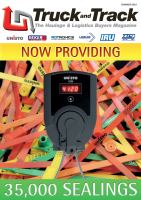
 www.truckandtrack.com
www.truckandtrack.com
Summer 2019
Truck and Track
55
DANGEROUS GOODS
The same data will be used to prepare the NOTOC.
This example is based on an export shipment in Air Transport, but it
works in a similar fashion for all modes of transport. Likewise, the
dataset can be used on the import side to generate manifests, road
transport documentation etc.
As this whole process is digital, it is as fast as sending and replying
by email. The benefit is that all parties are informed much earlier in
the process and many procedures in the logistics chain can be started
upon receiving the data. Also, corrections can be requested even
before the cargo leaves the shippers premises which, in the end, will
reduce delays, reduce rejections from incorrect documentation and,
very importantly, reduce the number of times that the same data
needs to be entered in the different systems used, thereby reducing
the likelihood of errors.
RS: IATA has also developed electronic systems, eDGD and DG
AutoCheck. How do these differ from DGOffice and are they
compatible with your software?
HT: The eDGD is an XML format tailored to Air Cargo and it is one of the
XML formats supported by DGOffice.
DG AutoCheck is specifically made to
help performing the acceptance checks
for Air Cargo and validates declarations
(both paper and digital versions), for
instance those generated by DGOffice -
and it is complementary to DGOffice.
RS: Has E-Freight been tested in
the real world and when will it go
“live”?
HT: Yes, there are three large E-Freight
projects running in Europe (Germany,
France and Switzerland) that DGOffice
is involved in. They use our knowledge
and/or software and, so far, the tests have been successful. The
first commercial project to go live was with Lufthansa Air Cargo in
Germany during May 2019.
RS: Stakeholders in the air industry appear to be leading
the way, but it seems that all transport modes could benefit
from adopting electronic data transfer. For example, during
the recent court case in USA, it was found that failings in the
transfer of critical product-related information contributed
to the events that led to the tragic MSC Flaminia incident of
2012. Do you think that E-Freight could have prevented the
disaster had this technology been available back then?
HT: I’m not sure if E-Freight would have prevented this incident.
However, if implemented and used properly, it would have made sure
that the information shared at the point of origin, and all additional
information added at a later stage, would have been available and
accessible to all those involved in the supply chain.
RS: How soon do you think that E-Freight will be ready for Sea
transport (or is it the other way round)?
HT: From a Dangerous Goods point of view, I would say it is available
now, but it needs to be implemented in a broader scope to be effective.
There are several projects on the way and, recently, 4 carriers
joined forces and started the Digital Container Shipping Association
(www.dcsa.org). Sothings are moving and we will participate in
as many initiatives as possible to support the development and
implementation of E-Freight.
RS: What about the other modes: Road, Rail and Inland
Waterways?
HT: Many integrators and express carriers are basically using
E-Freight already, as they have been paperless for years. I would say
that the same applies for these modes of transport as Sea Transport:
the systems are in place but some additional work needs to be done.
RS: This implies that it will not be too long before E-Freight
is the norm. How long do you think it will be before all DG
shipments are paperless?
HT: It’s a first step and a lot of work has been done in developing
standards to prove that the concept works. The next steps need to be
taken at political level where, for instance, customs procedures need
to be changed and other national requirements would need to be
adjusted; such as Training and Documentation demands.
Meanwhile, the E-Freight solution allows users to produce a PDF
version of a document at any given moment in the chain to comply
with paper demands. This allows companies to start using E-Freight
on routes that are open now, or even on parts of a route, to start
gaining benefits as soon as possible.
RS: Questions will, no doubt, be asked about how secure
the E-Freight process is when used up and down the supply
chain. What assurances can you give to potential customers
and users about the inbuilt security of using electronic data
transfer to support their shipments?
HT: The systems and procedures set up within our solution are such
that the involved parties can see and use the data they need. However,
they are not able to edit or remove data relating to a shipment. This is
particularly important where the legal liability, for instance, lies with
the Shipper of an Air Cargo shipment. This aspect was also judged in
the aforementioned E-Freight projects
and the solution we offered was
validated and approved to be secure.
RS: Technically, how big a step
change was it to build this new
technology in the existing DGOffice
software?
HT: We already had all the data in a
digital format - the challenge was (and
still is) to come to a standard in which
the data is offered to other parties.
As indicated, we participate in many
projects and we had noticed that an
overall multi-modal standard for DG Shipment was not previously
available. The standards that were being developed were focused on
one mode only, e.g. the eDGD format for Air.
Consequently, we started developing and publishing the DGXML
standard, an open XML format which can be adopted and used by
all modes of transport. From there we can, for example, generate the
eDGD message or other formats. We can also turn this around and
transforman air XML into amultimodal DGXMLmessage. This process
took us about a year to work out and implement in the running
projects.
RS: Clearly, there has been a lot of investment in developing
this solution. Howmuchdoes it cost for Shippers, Forwarders,
Carriers and Consignees to subscribe to the system?
HT: DGOffice is a modular build system, meaning a user just picks
the modules they need to tailor the solution to their situation. For
example, if a Freight Forwarder only required the E-Freight part, their
yearly fee would be approximately £205 / €240 / $265 per year.
RS:Many companies nowuse enterprise software such as SAP.
Is DGOffice, and the E-Freight modules within it, compatible
with ERP systems - either as an embedded tool or as a linked
resource?
HT: Yes, we have developed many web services and, via these web
services, most of the features in DGOffice can be used in other systems.
This would require some technical implementation on the customer
side, but our experience is that this is generally easy to implement.
So, such tasks as accessing regulatory information about products,
generating declarations and performing segregation checks, can all
be done using web services.
DGOffice: How it works for you
DGOffice is normally set up as an on-line browser-accessed
solution and users log in to the system with their own username
and password. The software is modular and tailored to suit
the requirements of your business. It is paid for on an annual
subscription basis which depends on a number of factors, such as
A single air freight
consignment can generate:
21 documents
sent 40 times
in 20 steps



















